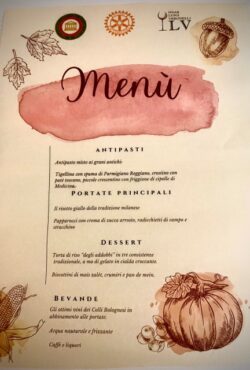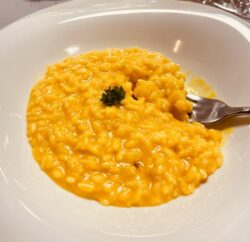Read Time: 4 Minutes Subscribe & Share
Food Groups
I just spent the most engaging evening at the Scuola Alberghiera Luigi Veronelli just outside of Bologna, even though I understood only about one word in twenty of the speeches and conversations. Italians are never brief. The event was a dinner sponsored by a group focused on Italian culinary history and the traditional recipes that reinforce it – L’Academia Italiana Della Cucina. We don’t have a similar group in the US, except for possibly the Southern Foodways Alliance, whose directors and membership record and promote traditional southern cuisine in the US, but also want it to survive and progress for future generations. Interestingly, this cultural association is closely aligned with the International Rotary Club and Lions Club, both of which have a strong presence in Italy.
Bologna, even though I understood only about one word in twenty of the speeches and conversations. Italians are never brief. The event was a dinner sponsored by a group focused on Italian culinary history and the traditional recipes that reinforce it – L’Academia Italiana Della Cucina. We don’t have a similar group in the US, except for possibly the Southern Foodways Alliance, whose directors and membership record and promote traditional southern cuisine in the US, but also want it to survive and progress for future generations. Interestingly, this cultural association is closely aligned with the International Rotary Club and Lions Club, both of which have a strong presence in Italy.
L’Academia Italiana Della Cucina was founded in Milan in 1953 and is traditionally composed of journalists, industrialists, and cultural advocates – divided into regional clubs with regularly elected officials. Each group visits restaurants in their region and rates them for inclusion in their online guide. It was a revelation to see such an association clearly delineate its regional cuisines as unique and historically valuable. And further, that these dishes should be taught and made delicious in succeeding generations. According to my host at this dinner, an innovation to a traditional recipe is not frowned upon, it just has to be good and respect the parameters of that recipe’s traditions. Their clubs in other countries focus on how regional Italian cuisine is interpreted abroad and are not shy about criticizing “dubious distortions.” Below is an approximate translation of the association’s mission statement on their site:
industrialists, and cultural advocates – divided into regional clubs with regularly elected officials. Each group visits restaurants in their region and rates them for inclusion in their online guide. It was a revelation to see such an association clearly delineate its regional cuisines as unique and historically valuable. And further, that these dishes should be taught and made delicious in succeeding generations. According to my host at this dinner, an innovation to a traditional recipe is not frowned upon, it just has to be good and respect the parameters of that recipe’s traditions. Their clubs in other countries focus on how regional Italian cuisine is interpreted abroad and are not shy about criticizing “dubious distortions.” Below is an approximate translation of the association’s mission statement on their site:
Cuisine is one of a country’s most distinctive cultural expressions: it grows from its inhabitants’ histories and lifestyles, which differ from region to region, city to city, village to village. Cuisine narrates who we are, rediscovers our roots, evolves with us, and represents us beyond our borders. The fruit of both tradition and innovation, it should therefore be safeguarded and passed on.
A Menu Of Grains
This unique dinner is held annually by all the member clubs (and also their international ones) on the same day, with a different theme chosen each year by their study group. Once the theme is chosen, each club organizes the meal to be served to its members and their guests in a particular culinary venue. It can be a restaurant, a food production facility, or in this case, a high school specializing in training its students in gastronomic industries, which include hotel and tourism management and, of course, classic professional kitchen skills as well as restaurant development.
on the same day, with a different theme chosen each year by their study group. Once the theme is chosen, each club organizes the meal to be served to its members and their guests in a particular culinary venue. It can be a restaurant, a food production facility, or in this case, a high school specializing in training its students in gastronomic industries, which include hotel and tourism management and, of course, classic professional kitchen skills as well as restaurant development.
One year, I was told, the menu’s theme was all things gelato –  savory, layered, sweet. This year it was “Rice, maize and other grains (wheat, farro, barley, oats and rye) in regional culinary traditions.” This menu’s list of featured ingredients is not an easy brief. And the students had to devise, along with their instructors, courses that would respect local culinary traditions. While not a final exam per se, creating the menu definitely feels like a test, with each course presenting grains in an innovative way that still represents regional cuisine. Certainly the risotto with saffron was an easy
savory, layered, sweet. This year it was “Rice, maize and other grains (wheat, farro, barley, oats and rye) in regional culinary traditions.” This menu’s list of featured ingredients is not an easy brief. And the students had to devise, along with their instructors, courses that would respect local culinary traditions. While not a final exam per se, creating the menu definitely feels like a test, with each course presenting grains in an innovative way that still represents regional cuisine. Certainly the risotto with saffron was an easy “winner”. And so was the dessert featuring a rice gelato, rice cake and crispy rice tuile. Obviously, the Academia had some co-sponsors whose products were donated for the production of the menu – one was a local rice producer, Grundi, and a scientist associated with the company gave a lecture on the history of rice and the varieties produced in Italy.
“winner”. And so was the dessert featuring a rice gelato, rice cake and crispy rice tuile. Obviously, the Academia had some co-sponsors whose products were donated for the production of the menu – one was a local rice producer, Grundi, and a scientist associated with the company gave a lecture on the history of rice and the varieties produced in Italy.
After the dinner, with much conversation, espresso and a selection of Italian Amari were served by the students and their instructors. A correct espresso is almost as important as other components to an Italian menu. In addition to my love for Italian coffee I have discovered how much I like the Italian universe of Amari, a class of bitter liqueurs that claims digestive virtues and that also has its regional divisions. Some are too antiseptic in taste for me – Fernet Branca, for example – but others, such as Montenegro, which is produced in Bologna, I quite like. As a newly anointed resident of this city, I felt quite validated in my taste when I read that the famous Italian writer Gabriele D’ Annunzio pronounced Montenegro to be the “liquor of virtues”.

Kitchen Detail shares under the radar recipes, explores the art of cooking, the stories behind food, and the tools that bring it all together, while uncovering the social, political, and environmental truths that shape our culinary world.




Comments are closed here.
Follow this link to create a Kitchen Detail account so that you can leave comments!